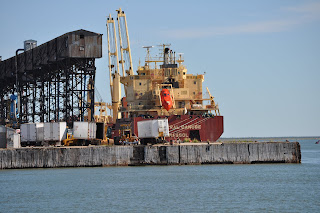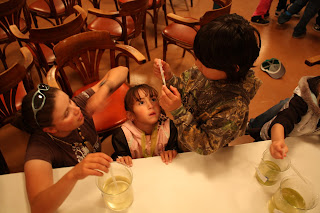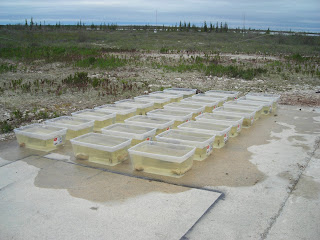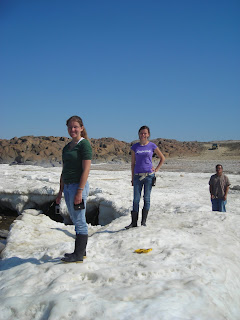Monday, December 20, 2010
A school for Attawapiskat
This article is about the Cree community of Attawapiskat and their fight for a new elementary school.
Additional information can also be found here.
We talk a lot about education in my lab and usually we focus on education at the post-secondary level, debating the merits of new methods in undergraduate education and perhaps sometimes lamenting resistance we may face in our departments and from students when confronted with new ideas in teaching. However, we take for granted the base education that has gotten all of us to this post-secondary level; our time spent at the elementary and high school levels. However we feel about the education we have received in the past, or the direction we feel the education system is going...we can't deny that many of us have been very fortunate. During the holiday season we often think more about inequality in the world (and rightly so), but let's not forget about similar issues facing people in our own backyard.
Tuesday, November 16, 2010
Applied science
Sunday, October 31, 2010
What do we do with all that science?
I think that another aspect that we have to consider in science is really how we do it and what we do with it once it has been done. I agree with Ingrid that we need to think carefully about what we are studying and why, because ultimately our science is going to have to stand for itself in the world and it is true that breaking down natural systems into measurable units may indeed detract from their instrinsic value.
However, I too feel that scientists have a role to play in environmental decision making and I think part of that lies not only with the ecology and the thinking behind it but also in the methods and application. The world is complicated. There are a lot of problems. We can discuss that forever and not get closer to solutions (we could probably also debate the meaning of the word "solution" for an infinite amount of time as well...), but there comes a point in time where we make a decision to study a problem and maybe even make recommendations. Regardless about where you stand on the second point, I think many of us can agree that all science has an impact. By impact I don't necessarily mean the impact that we want our research to have (ex. curing cancer, protecting an endangered species etc etc). I mean, obviously that is an end goal, but along the way our research will have other impacts: social, economic, environmental...impacts that we haven't even thought of.
I have been fortunate enough to work in the north for my MSc. I think the system I work on (aquatic rock pools) is important and that the problem I am interested in is equally applicable. But I also know that for every small bit of research I do, for every spreadsheet I have compiled and for every p-value I have gained through R there has been a train or plane that I took to Churchill and some soft tundra that I have repetitively compressed with my truck. This is why I think it is important for scientists to think more broadly about their research and ask important questions, not just research questions, but questions about how they are going to do research with the least amount of negative impact possible, and how they will ensure that their research reaches the audience it needs to after the fact (or during).
Alas, not sure if I have a picture that goes with this posting...
Wednesday, October 6, 2010
Let's Talk Science
Marina and I recently started volunteering with the program Let's Talk Science. This organization runs may different education and outreach activities and is unique in that it is powered almost solely by graduate students! Filled with ideas of things we would like to do with LTS, we realized that we needed a small project to start with. Enter Karl's oldest son's first grade science class! Next week, we will be facilitating a workshop for four grade 1/2 french immersion classes (don't worry we are permitted to talk in english- we double checked!) at a local Guelph public school.
Our theme is "The Wonderful Word of Microbes" or all things small, and one of our main focuses is on bacteria and viruses, both good, bad and just plain germy. In preparation we have been testing some interactive activities, mostly involving UV lamps and we are looking forward to the real deal next week.
So whether you believe promoting science education is important, or think interactive learning is the way to go, stay tuned for an update how our session with the students goes!
Planktoneer's write too? Well. We'll see about that.
Academia, now there is a word that I don't slip into casual conversation everyday (well actually I probably use it far too often...something I'm sure my housemates could attest too). Now according to Wikapedia, "Academia" refers to "the community of students and scholars engaged in higher education and research." Well I've always known that there was a lot of that going on on the 2nd floor of the science complex, and beyond...but Monday I officially entered the world of academia...well at least I sent in my membership application, i.e. I submitted my first manuscript.
So now I am waiting to find out if I will get to undergo the initiation ritual of the peer review process, or if my membership card will get "lost" in the mail...
Stay tuned for updates and perhaps a summary of the manuscript, so that students I have been working with for the last few years no longer have to ask, "so what do you do again?".
Wednesday, September 8, 2010
As the dust settles...

Intriguing though right? Like I would hang this on my wall as an abstract piece. Would you believe that all I had to do to create this (absolutely useless) masterpiece was to switch the x and y axes? Once I switched them back this transformed into a readable boxplot.
Exhibit 2: And then there were worms...
As part of my colleague Anne's (the shore bird researcher from Trent) work this summer she was measuring invertebrate biomass in the mudflats where SEPLs were foraging, to see if peaks in biomass conincided with chick hatching. This may sound simple, but when you are identifying insect larva to family level and then using specific equations based on individual measurements of individual specimens to calculate said biomass you end up with something that looks like this:

Now this is for 5 individuals of a single sample. Tedious? Yes. Accurate? Yes, and probably more so than drying and weighing the samples. I'll look forward to featuring this publication once this work at Trent University is done.
Saturday, August 21, 2010
My time is coming to a close...but not yet!
Thursday night included a lecture by Dr.Patricia Fitzpatrick from the Dept of Geography at the University of Winnipeg. She did a a very thought provoking presentation on the concept of why people choose to live where they live using Churchill as an example. Not only was it interesting to hear some of the results of her research, it was also neat to think about how you quantify and analyze data that includes opinions and feelings.

Christmas Lake Esker

A bowl-like mushroom.
Lundy's cabin...what a front yard! Not used (as far as I know) anymore and because it is now located in the Wildlife Management Area it cannot be sold out of th family (though I imagine there would be offers).
The esker, there is a road along the top that you can take all the way out to Gordon Point.
Sunday, August 15, 2010
Feels like fall is upon us...




The transition going on out on the tundra is really noticeable right now, the colours are different and the air has a different feel to it. Well back to some data analysis and R...another part of wrapping up a field season, getting ready to actually use the data you have spent months collecting!
Friday, August 13, 2010
My time in Churchill

I came down with a cold halfway through my stay which wasn’t much fun. It was during that time that I really missed being at home. Another thing I found different was being cut off from my friends. You can’t just pick up the phone and call someone. The only person I was able to talk to was my mother and even then you can’t say everything you want to because there are always people standing around you. I also really missed having my dog around, and it was really nice when Silver would come around or we got to play with Leah’s dogs. She’s a pretty cool girl, and I’m glad I got a chance to get to know her. She sent me off with half a homemade loaf of bread and butter, and two sandwiches for my train ride back to Winnipeg. It’s basically the best bread ever so I was very happy to get it.
My last day in Churchill was definitely one of my best. The wind had picked up the day before and the Bay was looking pretty angry. Unfortunately we weren’t able to sample due to the wind, but we had a fun morning exploring Miss Piggy and watching the waves crash on the beach. After Leah and I dropped Amanda off in town we went out to the front of bluff D to check out the waves there. It was pretty crazy. We were getting splashed way up on the rocks and covered in a salty mist. There were even bubbles flying off the rocks. Then we went for toasted bread and butter at Leah’s house, followed by some excellent tea. It’s always neat to run into people who love something as much as you do...mmm tea. Leah showed me a cool website where I can order loose leaf tea. In the afternoon we took down my last LC50 experiment, using the car to block the wind, and then I finished packing up my stuff and got ready to leave. Unfortunately I forgot my water bottle at the centre so I’m going to have to use some crummy one for the next couple of weeks. Amanda’s parents took us for a very nice dinner in town before my train departed. I had Arctic Char for the first time, which was very good. It was nice to have a full meal before my train left.
My train is pretty busy, I’m currently on it, although I did manage to get two seats to myself. Some woman decided she’d start having a conversation at 6am this morning. Thankfully she got off about an hour later and I was able to get back to sleep. I really miss being in Churchill already. It’s so beautiful there. I’m glad I was able to just chill on the shores of Hudson Bay before I left. Every time I’m on my way back from camping, I just like to sit on the dock, look out over the water, and breathe in the fresh air. The air was so nice in Churchill. One thing I missed was the smell of the forest. I went into the fen with Krista a couple times on her ATV. You drive through a bit of forest on the way there, and it smelled so nice. Other than that Churchill has everything, amazing wildlife, the Bay, and the Northern Lights, which I was thankfully able to see during my last week. It was a beautiful display, like colourful curtains of fog swirling overhead of me. One other cool thing I got to do while I was here was go canoeing with the Beluga’s at sunset. They were swimming all around our boat calling to one another. Even though I froze for a couple hours it was a wonderful experience.

I’d much rather be out sampling right now than stuck on this train, which is currently stopped again. I think the following picture truly sums up our field team and this summer...

Friday, August 6, 2010
Wind much?

Pretty impressive right? You can probably just picture the zooplankton dispersing and the saltiness of the pools increasing!
Ok, but now check out the surf from Aug.5, 2010 (thanks to Leah for these pictures!):



Just another WOW moment in science!
In other news, we finally took that rusty barrell out of one of the ponds on bluff D!

Monday, July 26, 2010
Two events


Thanks to Leeanne Dunne and Andy Jonhson for the pictures this time around.
Friday, July 16, 2010
The way things go...

Brittany has been here for a week now and will add a blog on her first impressions shortly! Tomorrow is Parks Day and we will venturing across the Churchill R to see the Prince of Wales Fort. Expect a post on that, the Research in Action Tour and the upcoming CNSC Olymp-a-thon shortly!
Thursday, July 8, 2010
Serious science (sort of)
 Watch out birders, I have now banded 3 birds! It has been really interesting to learn more about this study...with my research I am very focused on community level ecology and on abiotic processes as well to a certain extent. To learn more about how science is done at the population and behaviour level has been really neat.
Watch out birders, I have now banded 3 birds! It has been really interesting to learn more about this study...with my research I am very focused on community level ecology and on abiotic processes as well to a certain extent. To learn more about how science is done at the population and behaviour level has been really neat.
Being in Churchill also provides you with some unique recreational opportunities. On Canada Day, several researchers braved the cold waters of Hudson Bay to participate in the annual Bay Dip, a relay race into Hudson Bay. 
We are preparing for the CNSC's annual "Research in Action" tour so expect an update on that in the next few weeks!
In other news, Brittany has now arrived and will post a blog soon on her first impressions of Churchill and polar bears (yep they have arrived)!
Friday, June 25, 2010
A note to add about the microcosms
Sunday, June 20, 2010
Solstice and kids
But back to the great day. Today myself, Emily, Liz and Jinjing (fellow Guelph researchers) had the opportunity to visit a grade 3 class at the Duke of Marlborough school in town. We spent the morning gathering some plants, willow catkins, caterpillars, aquatic insects and of course zooplankton to show the students. The grade 3's just finished units about soils and plant growth and were eager to see all of the critters we brought in.
Liz explained how many aquatic insects make protective cases out of materials they find in the water and was able to show cases made of grasses, other plants, twigs and rocks. Emily showed how larvae use plants and specifically willow catkins to make their homes and explained how she is currently rearing several different species of caterpillars. I showed my groups several different types of zooplankton, explained how they overwinter, what they eat and taught the students how to focus on the small organisms under a microscope. The kids were all very eager to participate, from the student who told me all about krill to a student who insisted on showing all the other kids how she learned to focus the microscope.
The end of the session was spent playing a game simulating competition between animals for different habitats and resources. Overall a very fun afternoon and a great opportunity for us to share some of our science! Thanks to LeeAnn for setting up this chance for us, to Liz for the organization as well as to the students and their teacher for welcoming us into their classroom!
The experiments have begun.


Like Da Bluff, this site is also frequented by Da Bunny (although I doubt it is the same one we spotted frequently last year).

Basically, I have extracted ephippia (see my previous post) from various habitats, cold shocked them and then rapidly dried and rehydrated them to induce emergence (simulating the passage of a winter season). Now I have put them into small microcosms under various salinity conditions and will monitor emergence. In addition to control microcosms there are three other aspects that I am testing.

Thursday, June 10, 2010
Getting here...1 planktoneer arrived...2 to go
 (Map from VIA's website).
(Map from VIA's website). Here I attempt to share one an early morning scene on the tracks, just outside of Capreol, Ontario.
Here I attempt to share one an early morning scene on the tracks, just outside of Capreol, Ontario.Guelph is about 1957 km from Churchill...but of course that distance is if you could travel in a straight line. The actual distance travelled by train takes in a few more turns.While some of these km may seem desolate, the history of the train line is far from sparse. At rest stops along the way I was able to learn a little more about the railway. For instance, I learned that starting in the early 1900s, most railway stations had elaborate railway gardens, set up as showpieces that would be the first thing passengers would see as they entered a new community. The point of this was to encourage passengers in rural parts of Canada. I enjoyed the train and really do feel that it is a method of transportation worth supporting.
Since arriving in Churchill, I have delved into another research season as a planktoneer...
(Photo: taken by Krista Hanis)
and have been slowly been regaining my bluff legs. As a recap, my project focuses on freshwater zooplankton communities along the coast of Hudson Bay and how they respond to changes in environment, most notably, the saltiness or salinity of the water. This year I am really interested in how the resting stages of zooplankton ( for example, this Daphnia ephippia below- I also like describe them as dumplings) may impact zooplankton's ability to recover from disturbance and stress.
 The pouch like things pictured above are essentially dormant eggs released by mature Daphnia. And this is how our spotlight on travel fits in...Last year I spent a lot of time thinking about how zooplankton might "commute" around the rock bluffs without thinking much about the idea that sometimes it is easier to stay put and just wait out unfavourable environmental conditions- more on this later.
The pouch like things pictured above are essentially dormant eggs released by mature Daphnia. And this is how our spotlight on travel fits in...Last year I spent a lot of time thinking about how zooplankton might "commute" around the rock bluffs without thinking much about the idea that sometimes it is easier to stay put and just wait out unfavourable environmental conditions- more on this later.
Well my arrival back at the CNSC has been filled with science, catching up with friends from last year and enjoying some very hot spring weather. I'm looking forward to the rest of the summer and many more planktoneer adventures in this place where there is always more to learn.
Below are some pictures of some coastal exploration with some of the other researchers from Guelph: Liz, Emily and Jinjing.



 This is a specially crafted snowball...it has pieces of ice for extra protection...
This is a specially crafted snowball...it has pieces of ice for extra protection...Tuesday, June 1, 2010
Public service announcement
The Three Planktoneers (some old, some new) will be returning to Churchill this summer...stay tuned!

